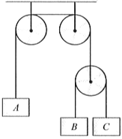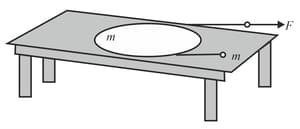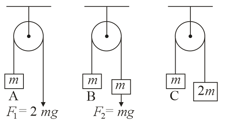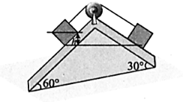In the system shown, block is of mass and blocks and are of equal mass each of . Find the acceleration in of block , if the system is set free,



Important Questions on Newton's Laws of Motion (Without Friction)
The given figure shows a block of mass placed on a bracket of mass . Bracket block system is moved downward with constant velocity on an incline. What is the magnitude of total force of bracket on block?

A block of mass is placed in a horizontal tube. Block fits the tube with a very small gap. A time dependent force acts on the system such that the resultant downward acceleration of system is given by its time. Which of the following graphs represents normal reaction of tube on block. Take downward direction as positive for . Initially block is in contact with lower surface.
In the arrangement shown in the figure, the system is in equilibrium. Mass of the block is and that of the insect clinging to block is . Pulley and string are light. The insect loses contact with the block and begins to fall. After how much time the insect and the block will have a separation between them.
Two blocks of equal mass have been placed on two faces of a fixed wedge as shown in figure. The blocks are released from position where centre of one block is at a height above the centre of the other block. Find the time after which the centre of the two blocks will be at same horizontal level. There is no friction anywhere.
A disc of mass lies flat on a smooth horizontal table. A light string runs halfway around it as shown in figure. One end of the string is attached to a particle of mass and the other end is being pulled with a force . There is no friction between the disc and the string. Find acceleration of the end of the string to which force is being applied.


In the given figure, blocks , and of mass each have acceleration , and , respectively. and are external forces of magnitude and , respectively. Then




